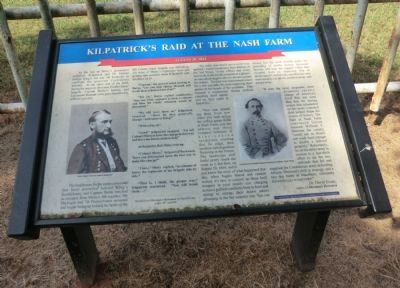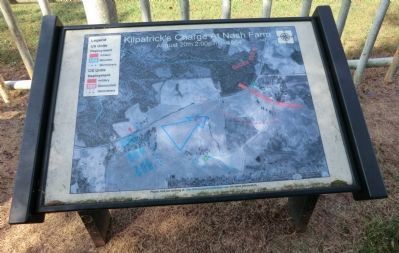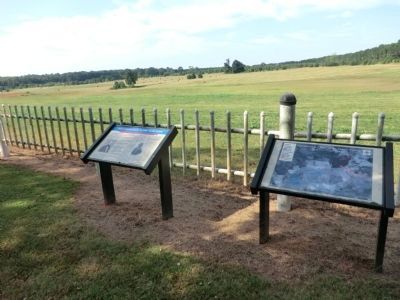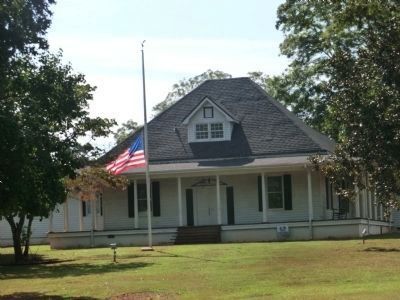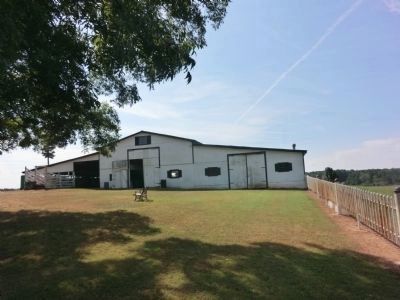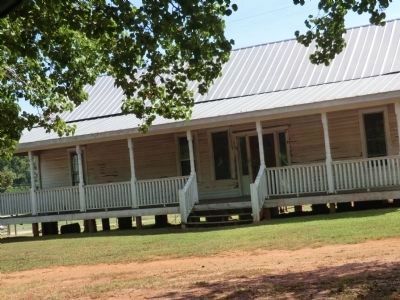Hampton in Henry County, Georgia — The American South (South Atlantic)
Kilpatrick's Raid at the Nash Farm
August 20, 1864
As the last of Minty’s skirmishers withdrew, Kilpatrick and Eli Murray realign King’s 3rd and 5th Kentucky to confront the quiescent Confederate infantry. At the other end of the field, facing the opposite direction, Fielder Jones’ brigade, Captain Beebe’s battery, and Lieutenant Bennett’s two guns blazed away at Ross’s cavalry.
The lead horses for the entire command had been corralled behind King’s Kentuckians, and Captain Burns watched as troopers from Minty’s 4th regulars, 4th Michigan and 7th Pennsylvania mounted and began lining up behind the brow of the hill Fielder Jones’ brigade was defending. All three of Minty’s regiments were just getting into position when Kilpatrick rode up about 2 p.m.
“Captain,” the general asked turning to Burns, “can your men charge through and break those rebels in front of us?”
“Yes Sir,” Burns replied confidently, “they can. Each regiment to form a column and then the rebels' attention would be distracted.”
“We will have them so,” Kilpatrick resolved. “How do they generally charge—with saber or firing?”
“With saber, sir”.
“Good!” Kilpatrick snapped, “Go tell Colonel Minty to have the charge in that way and drive the damn rebels to hell.”
At that point Bob Minty rode up.
“Colonel Minty,” Kilpatrick beckoned, “have you determined upon the best way to make this charge?”
“I have, “Minty replied, “in columns of fours; the regiments of my brigade side by side.”
“That is, I think, the proper way.” Kilpatrick concurred. “you will break them…”
Quoted from Sherman’s Horsemen by David Evans pages 447 and 448
“No order was heard; not a word was spoken,” noted Lieutenant Sam Barron of the 3rd Texas; “every officer and every man took in the whole situation at a glance; no one asked or gave advice: no one waited for orders. The line was maintained intact for a few seconds, the men emptying their pieces at the heads of the columns. This created a momentary flutter without checking their speed, and on they came in fine style.”
“You can almost see them. Even now when you look across the rolling green fields at Nash Farm, you can almost see three compact columns of blue-coated cavalrymen cresting that far ridge, their swallow-tailed guidons fluttering in the breeze. The landscape still looks pretty much the same as it did then, on August 20, 1864, and if you know the story of what happened that day, when bugles blared and cannon roared, it’s easy to conjure up those bold troopers in your mind’s eye, charging across a gullied cornfield, boot to boot and stirrup to stirrup, their drawn sabers gleaming in the hot summer sun. You can almost
feel the earth tremble under the pounding of nearly twenty thousand hooves, and hear the ragged volley that erupted from an opposing line of dismounted Confederate cavalrymen who were quickly cut down, swallowed up and swept away.
“It was the most desperate, most dramatic cavalry charge of America’s Civil War, but more than that, the stirring events that culminated on this hotly contested field helped shape the course of history. The fight at Nash Farm convinced Union General William T. Sherman his cavalry “could not or would not work hard enough to disable a railroad properly.” Reluctantly, he set his entire army in motion in a last-ditch effort to cut the two railroads that fed and supplied the Confederate army defending Atlanta. Sherman’s shift in strategy, and a two day battle at Jonesboro, ultimately forced the city to surrender.”
Dr. David Evans, author of Sherman’s Horsemen.
(captions)
(left) Union Major General Judson Kilpatrick.
(right) Confederate Brigadier General Lawrence Sullivan "Sull" Ross.
Erected by Georgia Civil War Commission.
Topics. This historical marker is listed in this topic list: War, US Civil. A significant historical year for this entry is 1864.
Location. 33° 27.486′ N, 84° 17.436′ W. Marker is in Hampton, Georgia, in Henry County. Marker can be reached from the intersection of Jonesboro Road and Babbs Mill Road, on the left when traveling south. The is located on the Nash Farm Battlefield Park. Touch for map. Marker is at or near this postal address: 4361 Jonesboro Rd, Hampton GA 30228, United States of America. Touch for directions.
Other nearby markers. At least 8 other markers are within 3 miles of this marker, measured as the crow flies. "The Old Bronze Gentleman of Lovejoy's Station" (within shouting distance of this marker); Locomotive Bell from the Nancy Hanks (within shouting distance of this marker); The "Right Flank" on the McDonough Road (within shouting distance of this marker); Kilpatrick's Raid (about 500 feet away, measured in a direct line); The Crawford-Dorsey House (approx. 1.3 miles away); Cavalry Action at Lovejoy's Station (approx. 2.1 miles away); Constantine Memorial (approx. 2½ miles away); Georgia Militia at Lovejoy's Station (approx. 2.6 miles away). Touch for a list and map of all markers in Hampton.
Also see . . . Nash Farm Battlefield. Explore Georgia website entry (Submitted on December 5, 2021, by Larry Gertner of New York, New York.)
Credits. This page was last revised on December 5, 2021. It was originally submitted on November 11, 2013, by Don Morfe of Baltimore, Maryland. This page has been viewed 974 times since then and 49 times this year. Photos: 1, 2, 3, 4, 5, 6. submitted on November 11, 2013, by Don Morfe of Baltimore, Maryland. • Bernard Fisher was the editor who published this page.
